Disclosure: We may earn commissions if you purchase products after clicking on a link from our site.
Are you interested in learning how to catch albacore tuna? Albacore tuna are highly sought after by anglers. They are identified by their elongated pectoral fins. You can find them in temperate and tropical oceans including the Atlantic, Indian, and Pacific Oceans.
In this article, we will discuss how to catch albacore tuna, the baits and lures, as well as fishing tackle to finally catch this fish.
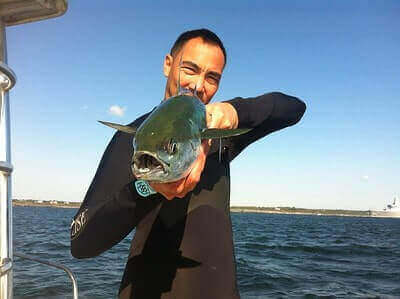
Table of Contents
How To Catch Albacore Tuna
Albacore tuna likes areas where cool and warm waters mix. They travel in large packs and travel vast distances. You can catch Albacore tuna on bait and lures. They have good stamina and will hard and long until exhaustion when caught. Trolling, jigging, drift fishing, and chumming are fishing methods used to catch them.
1. Trolling
Albacore tuna are located by trolling. Anglers will slowly move their boats over water while looking for Albacore tuna on their monitors. When they are located, chumming can be used to get them closer to the boat.
Trolling is a popular and effective method for catching albacore tuna. Anglers typically deploy multiple lines rigged with lures or bait behind a moving boat at varying depths to cover a wide area of water.
Albacores are known to swim in schools near the surface or at mid-depths, making them prime targets for trolling. Anglers can use diving plugs, spoons, squid imitations, or even live bait such as anchovies or sardines to entice strikes. Adjusting trolling speed and lure depth based on water temperature, current, and the presence of baitfish can increase the chances of success.
Once a strike occurs, anglers must quickly reel in the line to set the hook and then fight the fish to the boat. The National Oceanic and Atmospheric Administration (NOAA) provides information on albacore tuna fishing regulations and conservation efforts to ensure sustainable fishing practices.
2. Chumming
Chumming involves deploying a mixture of ground-up baitfish, fish oil, and other attractants into the water to create a scent trail that draws albacore tuna to the fishing area. Anglers typically use a chum bag or dispenser to slowly release the chum overboard while fishing.
Albacore has a keen sense of smell and can detect the scent of chum from a considerable distance, making this method highly effective for attracting them to the boat. Once albacore is present, anglers can deploy lures, bait, or live baitfish to entice strikes.
Chumming is often used in conjunction with other fishing methods, such as trolling or chunking, to increase catch rates. NOAA guides the proper use of chumming techniques and the importance of responsible chumming practices to minimize environmental impacts.
3. Drift Fishing
Drift fishing is a popular and effective method for catching albacore tuna. Anglers deploy multiple lines with bait or lures while allowing their boat to drift naturally with the current over known albacore grounds. This method covers a wide area of water, increasing the chances of encountering schools of feeding albacore.
Anglers often use live baitfish like anchovies or sardines, as well as artificial lures such as squid imitations or diving plugs to entice strikes. The key to successful drift fishing for albacore is to monitor water temperature, current speed, and the presence of baitfish. Albacores are known to prefer water temperatures between 60°F to 75°F and often feed near the surface or at mid-depths.
Anglers must be prepared to adjust their bait or lure presentation based on these factors to maximize their chances of success. Once a strike occurs, anglers must quickly set the hook and carefully reel in the fish to avoid losing it during the fight. NOAA provides valuable information on albacore fishing regulations and conservation efforts to ensure sustainable fishing practices.
4. Jigging
Jigging is a versatile fishing technique that can be highly effective for catching albacore tuna. Anglers deploy heavy metal jigs to rapidly descend through the water column, mimicking the movement of fleeing or injured baitfish. Albacores are known to respond well to vertical jigging, especially when they are holding at depth or actively feeding near the seafloor.
Anglers can vary the jigging action, speed, and depth to entice strikes from albacore. This method requires specialized jigging rods and reels capable of handling heavy jigs and fast retrieves. Additionally, anglers must be prepared for the physical demands of jigging, as it can be strenuous, especially when targeting larger albacore. NOAA provides information on recommended jigging techniques and gear for albacore fishing, as well as regulations to ensure sustainable fishing practices.
5. Live Bait Fishing
Using live baitfish is another productive method for targeting albacore tuna. Anglers can deploy live anchovies, sardines, or mackerel either on the surface or at varying depths using specialized rigs such as live bait rigs or downriggers. Live baitfish mimic natural prey and can be irresistible to hungry albacore.
Anglers must carefully handle and present live bait to ensure it remains lively and attractive to the fish. Additionally, maintaining proper baitfish size and rigging techniques is crucial for maximizing hook-up rates. NOAA guides the use of live bait in albacore fishing, including recommended baitfish species and handling practices to minimize harm to both the bait and the target species.
6. Casting
Casting lures or bait to actively feed albacore tuna can be an exciting and rewarding method of fishing. Anglers use spinning or casting rods to accurately cast lures such as metal spoons, surface poppers or swimbaits into areas where albacore are actively feeding on baitfish near the surface. This method requires keen observation and quick reflexes to identify feeding activity and accurately target the fish.
Once a lure is cast, anglers must retrieve it with varying speeds and actions to mimic the movement of fleeing or injured prey, enticing strikes from the albacore. Casting can be particularly effective when albacores are feeding in shallow water or near the surface, providing anglers with thrilling visual encounters as the fish aggressively attack their lures. NOAA provides information on casting techniques and gear recommendations for albacore fishing, as well as regulations to ensure sustainable fishing practices.
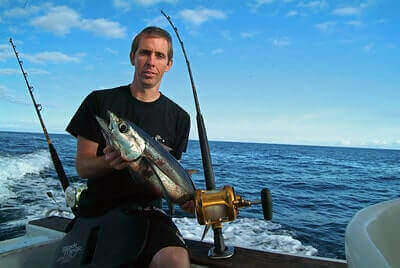
Albacore Tuna Fishing Tackle
Conventional and spinning tackle can be used when fishing for Albacore tuna. If you are using baits and lures to catch Albacore tuna, a 20-30 lb test line will work.
Best Baits For Albacore Tuna
- Squid
Squid is a highly effective bait for albacore tuna fishing due to its natural appearance, enticing scent, and resilience on the hook. Albacore tuna are voracious predators known to feed on squid, making it an ideal choice for anglers targeting these fish. Squid can be rigged in various ways, including whole or in strips, depending on the angler’s preference and the fishing conditions.
Some anglers opt to use fresh squid, while others prefer frozen squid that has been thawed. When rigging squid for albacore fishing, it’s essential to present it in a lifelike manner, mimicking the squid’s natural swimming motion. Anglers often deploy squid rigs with multiple hooks to increase their chances of hooking into feeding albacore.
Additionally, adding scent attractants or glow-in-the-dark features to the squid can further enhance its appeal to albacore in low light conditions or at greater depths. Squid can be fished both near the surface and at deeper depths, depending on where the albacore is feeding. Anglers should be prepared to experiment with different rigging techniques and depths to find the most productive presentation for the day. NOAA provides valuable information on albacore fishing regulations and conservation efforts to ensure sustainable fishing practices
2. Sardines
Sardines are an excellent bait choice for albacore tuna fishing due to their oily texture, strong scent, and natural resemblance to the small baitfish that albacore prey upon. These small, silvery fish are a staple in the diet of albacore tuna and are readily accepted as bait. Anglers often use whole or chunked sardines rigged on circle hooks or J-hooks to target albacore.
The natural oils released by sardines in the water create an attractive scent trail that can lure the albacore from a distance. Sardines can be fished at various depths, from surface trolling to deep drop rigs, making them versatile bait for anglers targeting albacores in different water conditions. When fishing with sardines, anglers should ensure that their bait is presented in a lifelike manner to entice albacore strikes effectively.
Adding attractants such as squid scent or artificial fish scents can further enhance the appeal of sardines to albacore. Proper storage and handling of sardines are essential to maintain their freshness and effectiveness as bait. NOAA provides valuable information on albacore fishing regulations and conservation efforts to ensure sustainable fishing practices.
3. Anchovies
Anchovies serve as an exceptional bait choice for albacore tuna fishing, primarily due to their small size, shiny appearance, and strong scent. These baitfish closely resemble the natural prey of albacore tuna, making them highly effective in attracting these pelagic predators. Anglers often utilize anchovies either whole or rigged on hooks, with variations such as live bait rigs or daisy chains commonly employed to enhance their presentation.
Anchovies emit natural oils and scents when in the water, creating an enticing scent trail that can attract albacore from considerable distances. Furthermore, their silver coloration and fluttering motion in the water mimic injured or distressed baitfish, further enticing albacore strikes. Anchovies can be fished at various depths, making them suitable for both surface trolling and deep-drop fishing methods.
Anglers need to handle anchovies carefully to maintain their freshness and prevent damage to their delicate bodies. Additionally, ensuring proper storage conditions, such as keeping them chilled or frozen, helps preserve their effectiveness as bait. NOAA offers valuable resources on albacore tuna fishing regulations and conservation measures to promote sustainable fishing practices.
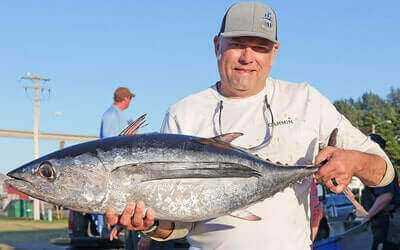
Best Lures For Albacore Tuna
- Cedar plugs
Cedar plugs are a tried-and-tested lure for targeting albacore tuna, prized for their simplicity and effectiveness. These wooden lures are designed to mimic the appearance of small baitfish, particularly squid or small tuna, which are the primary prey for albacore.
The slender, elongated shape of cedar plugs allows them to create a realistic swimming action when trolled through the water, making them irresistible to hungry albacores. Anglers typically deploy cedar plugs by attaching them to trolling rigs and towing them behind a boat at various speeds. The natural wood construction of cedar plugs offers durability and buoyancy, allowing them to withstand the rigors of offshore trolling.
Additionally, some cedar plugs feature metal or plastic inserts to enhance their reflective properties, further increasing their visibility to albacore. These lures can be effective at different depths, depending on the trolling speed and line weight used, allowing anglers to target albacore both near the surface and at deeper depths.
It’s essential to experiment with trolling speeds and lure configurations to find the most productive setup for the prevailing conditions. NOAA provides valuable guidance on albacore tuna fishing techniques and conservation practices, ensuring sustainable angling opportunities for future generations.
2. Tuna feathers
Tuna feathers, also known as feather jigs or feather rigs, are highly effective lures for targeting albacore tuna in offshore waters. These lures consist of a series of brightly colored feathered hooks arranged in a cluster, resembling a small baitfish or squid school. The vibrant colors and lifelike movement of the feathers mimic the appearance and behavior of albacore’s prey, making them irresistible to these voracious predators.
Anglers typically deploy tuna feathers by attaching them to trolling rigs and towing them behind a boat at various speeds. The multiple hooks on a tuna feather increase the chances of hooking multiple fish simultaneously, maximizing catch rates.
These lures are versatile and can be trolled at different depths, allowing anglers to target albacore both near the surface and at deeper depths. Tuna feathers are renowned for their ability to entice albacore into aggressive strikes, often resulting in explosive surface action and thrilling battles. Anglers should vary trolling speeds and adjust lure depth to find the most productive setup for the prevailing conditions.
3. Soft plastics
Soft plastics, such as swimbaits and rubber squids, are increasingly popular lures for targeting albacore tuna, particularly in areas where live bait may be scarce or impractical to use. These artificial baits offer several advantages, including durability, versatility, and lifelike action.
Soft plastics can be rigged in various configurations, including on jig heads or as a trailing lure behind a trolling skirt. Their soft, flexible bodies mimic the movement of baitfish or squid, enticing albacore to strike. Anglers often customize soft plastics with scent or flavor enhancers to further entice bites.
When targeting albacore with soft plastics, anglers typically deploy them using trolling or casting techniques. Trolling soft plastics behind a boat allows anglers to cover a large area and search for actively feeding fish.
Casting soft plastics near schools of bait or structures where albacores are known to congregate can also yield successful results. These lures are effective at various depths, depending on the rigging and trolling speed. Anglers should experiment with different colors, sizes, and retrieval speeds to determine the most effective presentation for the day’s conditions.
4. Metal jigs
Metal jigs are highly effective lures for targeting albacore tuna due to their versatility, durability, and ability to mimic the movement of baitfish. These lures come in various shapes, sizes, and colors, allowing anglers to match the prevailing conditions and preferences of the fish.
Metal jigs are typically rigged with strong treble hooks and feature a shiny, reflective surface that catches the attention of the albacore from a distance. Anglers can employ a variety of techniques when using metal jigs, including casting, jigging, or trolling.
Casting metal jigs toward feeding frenzies or surface activity can elicit aggressive strikes from albacores, especially when they are actively feeding near the surface. Jigging metal jigs vertically beneath the boat is another effective technique, particularly when targeting deeper-dwelling albacore or when fish are holding tight to the structure.
Additionally, trolling metal jigs behind a boat at varying depths allows anglers to cover a large area and search for actively feeding fish. Successful anglers often experiment with different jigging actions, retrieval speeds, and depths to determine the most effective presentation on any given day.
5. Spoons
Spoons are popular lures for targeting albacore tuna due to their versatility, durability, and ability to mimic the movement of baitfish. These lures are typically made of metal and feature a streamlined shape with a shiny, reflective surface that mimics the flash of baitfish in the water.
Albacore is known to be attracted to fast-moving prey, and spoons excel at imitating the erratic darting action of fleeing baitfish when retrieved at high speeds. Anglers often use spoons in combination with trolling rigs, allowing them to cover a large area of water and locate actively feeding albacore.
Additionally, spoons can be cast and retrieved or jigged vertically beneath the boat, making them suitable for various fishing conditions and techniques. When trolling, anglers typically rig spoons with a leader behind a planer or trolling weight to achieve the desired depth.
Successful anglers may vary the speed and depth of their presentation until they locate actively feeding albacore. Additionally, spoons can be rigged with single or treble hooks depending on angler preference and local regulations.
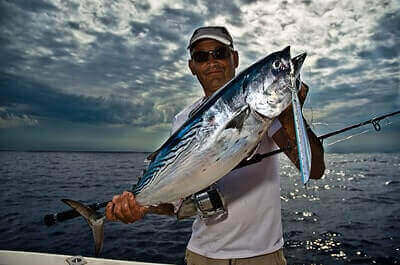
Albacore Tuna Fishing Tips
- Albacore tuna spawn in the winter.
2. Albacore Tuna likes areas where cool and warm waters mix.
3. Squid, sardines, and anchovies are some of the baits used to catch Albacore tuna.
4. Albacore tuna will put up a long and hard fight when caught.
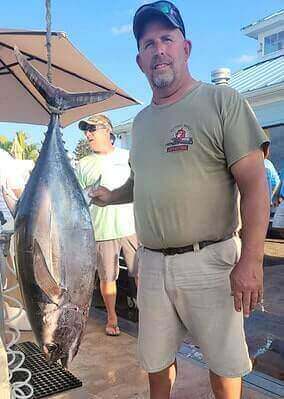
5. Trolling, jigging, drift fishing, and chumming are fishing methods used when fishing for Albacore tuna.
6. Cedar plugs, tuna feathers, metal jigs, and soft plastics are some of the lures used to catch Albacore tuna.
7. Albacore tuna is always on the move. Swimming a lot of distance in their lifetimes.
8. Albacore tuna can go on long runs when hooked; therefore, bring enough line when fishing them.
9. Albacore tuna can be caught on lures and baits.
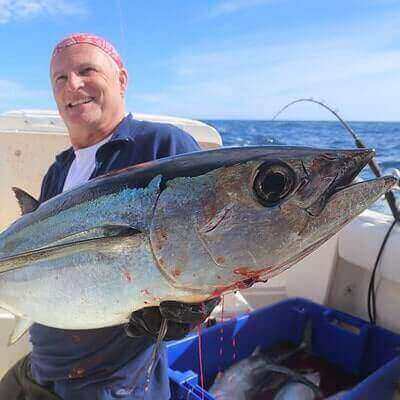
10. When fishing for Albacore tuna, search for them around the edges and canyon tips.
11. Albacore tuna are attracted to Green Machines. Create a trail of Green Machines and Albacore tuna will show up.
12. Zigzag the boat so that the lures move in and out of the water. Albacore tuna is attracted to the movement of lures going in and out of the water.
13. Albacore tuna travel in large packs. When you catch one, work that area as there may be others in that area.
14. Conventional and spinning tackle can be used to catch Albacore tuna.
15. Albacore tuna is a schooling fish.
16. Albacore tuna has good eyesight. Therefore, fluorocarbon leader is the best option to reduce visibility.
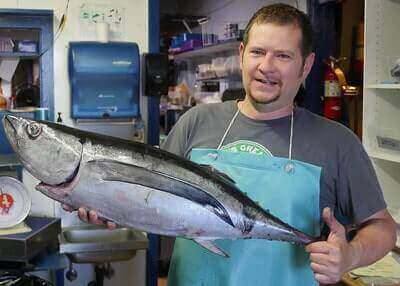
The Bottom Line
Albacore tuna is a sought-after fish. They are found in the Atlantic, Pacific, and Indian Oceans. In the United States, Albacore tuna are found on the west coast. They are tasty, fight hard, and make long runs when hooked.
Additionally, they can be caught using bait and lures. Anglers usually troll the waters to locate them. Chumming is also used to attract them to the boat. In this article, we discussed how to catch Albacore tuna, the baits and lures to use as well as share more information about this tasty fish to help you catch them. You can also read how to catch bigeye tuna, how to catch yellowfin tuna, how to catch alligator gar, and how to catch blackfin tuna.